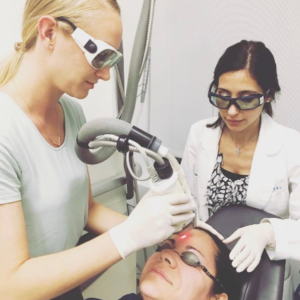Everything You Need To Know About Fraxel Lasers

If you’re considering giving Fraxel a try, consider this your beginner’s guide to the treatment for both results and recovery.
What does Fraxel lasers treat?
Think of Fraxel as a more advanced, less invasive facelift. It rejuvenates the skin, improving texture and tone. Fraxel is commonly used to treat wrinkles, fine lines, loose skin, age spots, acne scars, sun damage, uneven skin tone or color, melasma, surgical scars, broken blood vessels, and rosacea. Fraxel can be used to treat your face, chest, hands, and neck, and it’s safe for any skin type and color.
Do Fraxel lasers hurt?
Before performing Fraxel treatment, your dermatologist will apply a topical anesthetic ointment to your skin. This numbs the skin so the treatment won’t cause any pain, and it’s the only type of anesthesia you’ll need for Fraxel.
How many treatments will I need?
You’ll most likely start seeing results after your first Fraxel treatment session. Based on the outcome you’d like, your dermatologist will recommend a number of treatment sessions, usually spaced two to four weeks apart. Many patients are satisfied after three to five sessions, and results should be optimal after two to three months.
Are there any side-effects?
Of course, you’d hate to go in for healthier, smoother skin only to experience side effects and have your skin look worse than before. Don’t worry, though: for the vast majority of patients, that won’t happen. While there is a risk of scarring and infection, that risk is very low. After downtime, your skin should return to normal – only much better. Still, if you’re concerned, talk to your dermatologist about whether or not Fraxel is a safe option for you. If it is, you may have just stumbled upon the secret to looking like Kim Kardashian (as far as your skin is concerned, anyway).
What’s the downtime following a treatment?
That’s one reason this treatment is popular; another is that it tends to come with less down-time than other types of treatment. Afterward, your face may look a little sunburned and possibly swollen. Then, you might notice the skin taking on a bronzed look. Depending on which type of Fraxel treatment you decide on, your downtime will vary.
What To Expect After Fraxel
- First 3 days: the skin will look red and possibly swollen. It may ooze a little or become crusty. To keep the skin healthy during this period, you’ll want to stay hydrated and avoid itching. Your dermatologist will give you more specific instructions on how to care for your skin following Fraxel treatment.
- Days 4 – 6: The redness and swelling should start to decrease, though your skin may still look a little crusty. Use some lotion to keep it hydrated.
- Day 7+: At this point, your skin might be a little pink and flaky. You can cover this with make-up if you want to. Be sure to wear sun lotion, as your skin will be sensitive.
You may wish to stay home for the first few days, and if you go outside you’ll want to be careful about exposing your skin to the sun. But in this case, “downtime” doesn’t necessarily mean bed rest. You’ll still be able to do most of the things you normally do on an average day.
